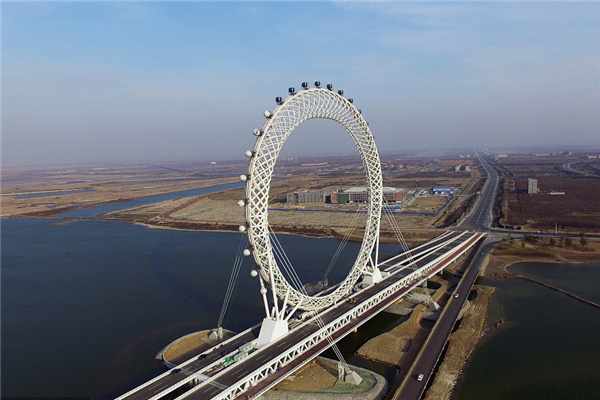

|
A bird's eye view of earthquake-devastated Maoxian county in Sichuan province. Maoxian was traditionally a major agricultural production base and tourism destination in Southwest China. |
In addition to its massive physical destruction, the devastating May 12 earthquake will deliver multiple aftershocks to the economy of the worst affected region, Sichuan province.
The quake is currently estimated to have indirectly caused 30 to 60 billion yuan in damage and the total economic losses could be as high as 105 billion to 190 billion yuan, the Southwest Securities research and development center predicts.
The quake will also slow the growth of the nation's economy by 0.15 to 0.2 percentage points during the second to fourth quarter of the year, it adds.
The impact will differ in various areas and the total loss will exceed the January blizzards, which cost the economy 151.7 billion yuan.
Agriculture
The quake has seriously affected agricultural production in Sichuan and other regions, says Wei Chao'an, agriculture vice-minister.
The earthquake, which triggered landslides in the mountainous province, has damaged 33,333 hectares of farmland, including more than 10,000 hectares of wheat and rapeseed and more than 20,000 hectares of vegetable plantations, in the 13 worst-hit cities and counties of Sichuan province, Wei says.
"A large amount of farming facilities, including more than 20,000 farm machines, have been damaged," Wei says.
Around 50,000 greenhouses have collapsed while 600,000 bio-gas pools have been damaged.
Because the disaster also destroyed irrigation systems in some areas, up to 100,000 hectares of rice paddies might have to be used to grow alternative crops, he says.
He says the repair work would be very difficult.
As the country's leading agricultural province, Sichuan provided 6 percent of the nation's total grain output, including 5 percent of the national total summer grains, 8 percent of the total vegetable oil crops and 5 percent of the total vegetable production, says Wei.
The total grain production is expected to be reduced 8 to 10 percent in Sichuan this year.
But, Wei says the quake has had a limited impact on farm production nationwide, adding he had full confidence in a continued steady national supply of grain and other major products and stable prices.
Most of the 12.5 million livestock killed in the quake were mostly poultry.
The poultry losses were a small fraction of the 1.5 billion poultry that the province hoped to produce in 2008, says Wei.
And roughly 8,000 tons of fish have died or escaped, after 2,000 hectares of fishery ponds were damaged.
Sichuan also accounts for 11.6 percent of the nation's pork production and the disaster has raised concerns over the already steep pre-quake rise of pork prices and inflation. The price of pork is currently 22 to 27 yuan per kilogram. As of April the consumer price index (CPI) was 8.5 percent.
In the short term, Sichuan pork exports will be reduced by 50 percent while the nation's pork prices may rise 6 percent, says Chu Jianfang, analyst of CITIC Securities. She adds that pork price rises may drive the CPI up 0.3 percent.
Wei says the ministry will compensate for the agricultural losses by stepping up production in other areas and closely monitoring farm produce supplies in the affected areas.
According to statistics by the Ministry of Agriculture, at present, the agricultural production market remains stable without any large fluctuations.
Metallurgy
The 8.0-magnitude earthquake is also seriously affecting the Sichuan metallurgy industry, and in other quake-hit provinces due to damaged facilities, disrupted transportation and power outages.
At least 10 zinc smelters with a total capacity of 470,000 tons have been shut down in Sichuan, Gansu and Shaanxi.
The largest zinc smelter in Sichuan with an annual capacity of 80,000 tons, owned by Sichuan Hongda Co, has suspended production for at least half a month, according to Antaike, a non-ferrous metal research body.
Zinc production in Sichuan province accounts for 10 to 15 percent of China's annual amount.
As for aluminum, Sichuan Aostar Aluminum Co and Sichuan Guangyuan Aluminum Co, with a combined smelting capacity of 370,000 metric tons, also faces production curbs after the disaster.
Sichuan Aostar, the largest producer of the metal in the province, has only enough material stockpiles to feed its plant for 10 days, Tang Yan, an operational manager, says.
Transport on the main Baoji-Chengdu railway is disrupted, cutting a third of Aostar's monthly alumina supply of 22,000 tons for one of its two plants.
Despite of negative impacts, the demand for non-ferrous metals is expected to rise during the area's reconstruction stage, says Huang Anle, analyst of Guosen Securities.
Cement
In Chengdu, Deyang, Mianyang, Guangyuan, Ya'an and other quake-stricken cities in Sichuan province, buildings with more than 4.4 million rooms have collapsed, according to Xinhua. In some worst quake-hit areas, 80 percent to 90 percent of the buildings have been destroyed, and about 45,000 rooms in Gansu province and 30,000 rooms in Shaanxi province were also destroyed.
The demand for cement in the post-earthquake reconstruction is estimated at above 50 million tons, a China Merchants Securities' research note predicts, adding that the average cement consumption for residential buildings is between 200 to 300 km per sq m.
In 2007, the output of the cement industry in Sichuan and its neighboring provinces was 62 million tons and 140 million tons respectively, the report says. It estimates Sichuan and its neighboring provinces will have an increased cement production of 35 million tons this year, an amount which can hardly meet the potential demand.
To cater to the strong demand for cement, at least 22 new dry-kiln cement production lines with a capacity of 5,000 tons per day each need to be put into place.
According to a research note by Huatai Securities, there were 310 cement enterprises in Sichuan province by the end of 2007. And since the province had stepped up efforts to close out-of-date production facilities, the strong demand in the post-quake reconstruction will further add to the imbalance of the cement's supply and demand chain, and mean higher cement prices.
The post-quake reconstruction will also boost demands for other construction materials and machineries.
Tourism
For tourists and visitors who may have planned to visit the world heritage sites of Qingcheng Mountain and Dujiangyan irrigation system, one sight they will not be able to see is the Erwang Temple. The Qing Dynasty (1644-1911) wooden complex was leveled when the earthquake jolted the area on May 12.
Erwang Temple is not the only tourism destination in Sichuan province that was severely damaged by the earthquake. According to the State Administration of Cultural Relics, 45 national level and 59 provincial level cultural relics have been damaged, some of which were completely destroyed. That doesn't count the natural scenery blighted by the quake and landslides.
It's a crushing blow to the province's tourism sector. Endowed with rich natural and cultural tourist attractions, Sichuan is the only province in the country whose tourism revenue makes up more than 8 percent of the provincial GDP. Last year, Sichuan received 1.86 billion domestic tourists and 1.71 million tourists from abroad, reaching a total turnover of 121.7 billion yuan.
Zhang Gu, director of the Sichuan tourism bureau, says that direct economic losses in the tourism sector caused by the earthquake are estimated to exceed 50 billion yuan. Some of the travel agencies described the impact as "devastating", as the 21st Century Business Herald reported.
The chaos of disrupted and destroyed public facilities such as transportation and communication systems currently makes traveling in Sichuan province almost impossible.
On the day of the earthquake, the China National Tourism Administration issued an emergency notice asking tourists not to visit or pass through the quake-hit areas, and travel agencies to halt their business in the region temporarily.
"The Jiuzhai-route will suffer the most severe loss from the quake," says tourism analyst, who adds that 60 to 70 percent of travelers visiting Sichuan province choose the route before the earthquake.
"But now the business has been halted, this means the entire tourism sector's income will remain zero," the analyst says.
Tang Jian, an analyst from SinoLink Securities, predicts that inbound travel to Sichuan province is likely to reduce significantly in the short term for both infrastructure shortage and mental fears leftover from the earthquake.
CBW news
(China Daily 05/26/2008 page10)













